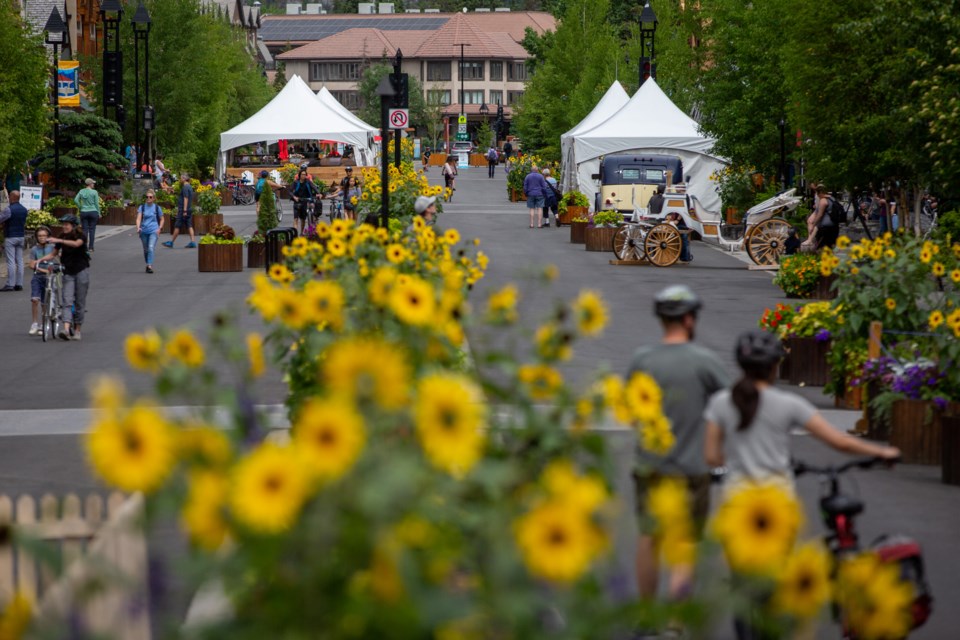BANFF – A decision to allow restaurants and retailers to expand their businesses into Banff’s new downtown pedestrian zone is causing conflict and debate over fairness of use of public space.
The Town of Banff has long had a policy that allows sidewalk seating and cafés, but the closure of the 100 and 200 blocks of Banff Avenue to vehicles to provide more space for physical-distancing during the COVID-19 pandemic has generated more interest than ever before.
Officials say the planning and development department is processing upwards of 40 applications, two thirds of which are for cafés and restaurants and the rest for outdoor merchandising.
Darren Enns, the Town of Banff’s director of planning and development, said there is a stronger interest for cafés and restaurants than there is space available, noting street-level businesses get priority if there is space in front of neighbouring properties.
“Once we saw cafés installed, there was a strong interest from both basement and second-storey tenants as well as restaurants that might be on adjacent streets like Bear Street to come over to Banff Avenue and open up,” he said.
“This, of course, is challenging in a land-constrained community that we just don’t have the space to accommodate everyone, and so we’ve hit pause on any second-storey or basement restaurant applications at this time.”
Councillor Ted Christensen has raised concerns about the sense of fairness to all businesses.
“If some businesses in lower levels or basements or upstairs express concern, and then they see someone with more space because their adjacent street level partner is not using them, there seems to be an element of favouritism or special treatment,” he said during a recent council meeting.
Fabio Wagner, owner and operator of Rundle Gifts in Cascade Shops at 319 Banff Ave., is calling on the Town to also consider closing the 300 block of Banff Avenue to vehicles.
He’d like to see other businesses in town be able to apply for outdoor space in the closed area.
“Maybe certain businesses would not get as large of a space, but then the Town is trying to help all our local businesses and not just the few on the ground floor of the 100 and 200 block of Banff Avenue,” he said in a letter to council this week.
The planning and development department uses several filters when assessing whether businesses can use space beyond their store frontage, including a written agreement from the neighbouring landlord.
“We quickly realized that a number of businesses would not be making use of their allocated area and a lot of retailers would rather invest in their storefront space as opposed to the street space,” Enns said.
“In those situations, and if there was an adjacent business that wanted to make use of that space, we looked at a few factors – the first, of course, was the permissibility of that from the adjacent tenant’s and landlord’s perspective,” he added.
“We didn’t want to set out to create conflict and we wanted to make sure adjacent neighbours had been consulted prior to that conversation occurring … it’s up to the landlord to deal with inter-tenant conflict within their properties.”
Enns said an application is also considered from a public interest perspective, based on how setting up businesses in the street could affect safe pedestrian movement.
“Would an expanded footprint reduce the ability of pedestrians to move from a sidewalk to the open street? That was a critical issue for us,” he said.
“We didn’t want anyone, let’s say, impeding a mid-block crossing or a curb cut in the sidewalk, because we felt that was a private interest taking precedence over a public one.”
Meanwhile, Wagner said the "large circus-like tents" for outdoor restaurants are taking away a lot of the space that was supposed to allow for social distancing and safety.
“Was any thought given to using the lanes closest to the sidewalk for restaurant patios and retail displays? Leaving the inside lanes open for the flow of pedestrians?” he wrote in his letter.
“What about our awe-inspiring views? Instead of a vibrant, alive pedestrian street with outdoor patios that have classy tables and umbrellas allowing our visitors to enjoy a meal or drink and take in the views, we have a line of circus tents.”
While he understands the decision to close the 100 and 200 blocks of Banff Avenue to vehicles was made quickly, Wagner still hopes there’s further consideration to include the 300 block, too.
“The Town is directing visitors to use the new Liricon parking lot and walk into town,” Wagner said, noting the main route will be Elk Street to Banff Avenue.
“Now the people are arriving on the 300 block and crowding down that sidewalk to get to the pedestrian zone,” he added.
“Maybe this was thought about after and that is why my store is being sacrificed to make the sidewalk bigger now.”
“This summer is not going to be like any one we have experienced before,” he said, noting outdoor merchandising has been proven to increase visitation and sales to a store by as much as 35 per cent.
“Every business will need to take every advantage available to be able to survive these unprecedented times.”
Enns said closing the 300 block was not considered, adding administration strongly believes the Wolf Street east-west connection is critical to moving vehicles across town.
“By keeping Wolf street open, of course it’s most effective if you provide access to it,” he said.
“Our belief was that the 300 block needed to remain open throughout this period in order to provide that connection to Wolf Street.”



